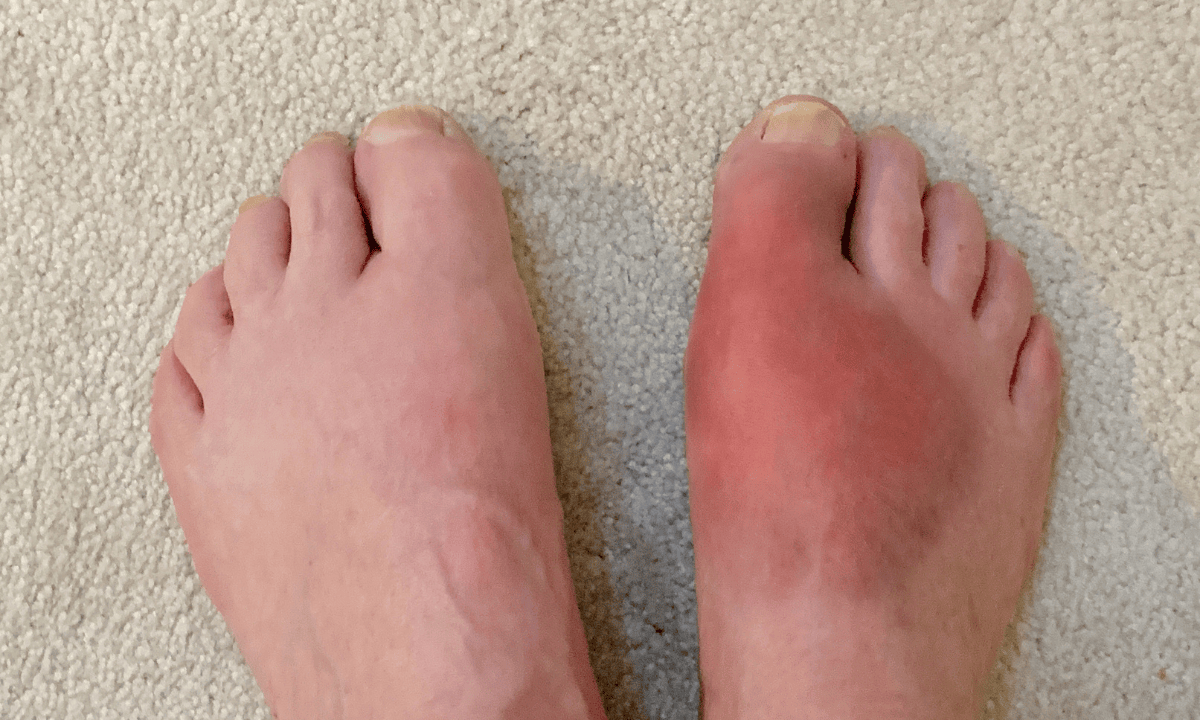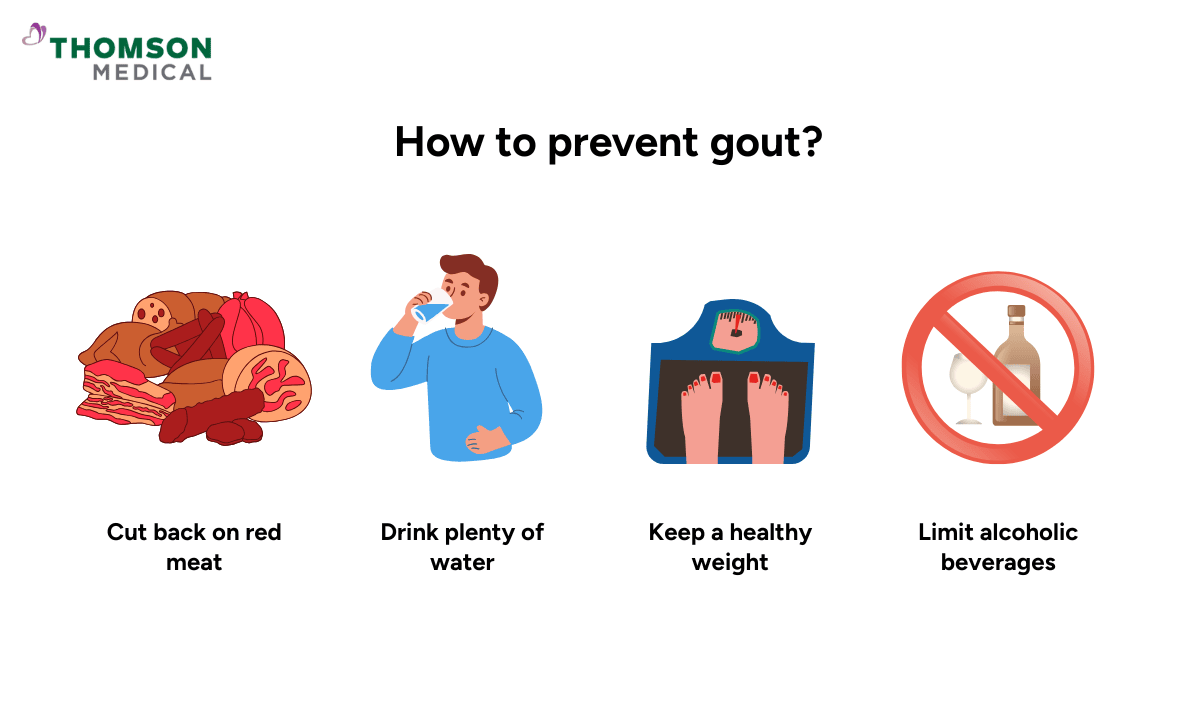Have you ever experienced sudden, intense joint pain that seems to come from nowhere? It may even wake you up at night, leaving you unable to move the affected joint without experiencing pain. While many people think it's just a sprain or the result of intense exercise, recurring pain could indicate gout, a condition which is often misunderstood or dismissed as a minor joint problem.
However, this condition can make simple daily movements a significant challenge. Understanding what gout is, why it occurs, and how to manage it early on can help you stay active.
What is gout?

Gout is a type of inflammatory arthritis caused by a build-up of uric acid crystals in the joints. When these crystals form, your immune system responds by releasing inflammatory cells, which causes pain, redness, heat, and swelling. Gout typically affects the big toe, but it can also affect other joints, such as the ankles, knees, elbows, wrists, and fingers.
What are the symptoms of gout?
A gout attack often begins without warning. The most common symptoms are:
- Intense joint pain:
- The most common symptom is intense, sharp pain, usually in the big toe but can occur in any joint (feet, knees, ankles, elbows, wrists, and fingers).
- Redness and swelling:
- The affected joint may become red, swollen, and warm to the touch.
- Limited range of motion:
- As the inflammation progresses, the joint may become stiff, reducing mobility.
- Lingering discomfort:
- After the severe pain subsides, discomfort in the joint may last from days to weeks.
You should see a doctor if you experience sudden joint pain, swelling, or redness, as early treatment can prevent further attacks.
What causes gout?
Gout can happen when uric acid builds up in the blood and forms crystals in the joints. Certain lifestyle habits and health conditions can cause or make gout worse.
Some common causes of gout include:
Eating foods high in purines (natural substances in food that break down into uric acid) like red meat, organ meats (liver, kidney), seafood, and some fish
Drinking alcohol
Not drinking enough water
Being overweight or gaining weight quickly
Taking certain medicines
Having kidney problems that stop uric acid from leaving the body properly
Family history of gout
Physical or emotional stress, injury, or surgery
Who is likely to be affected by gout?
Gout is more common in men, especially from their 40s onwards. Women usually get it after menopause. It can also run in families.
People with metabolic syndrome (a group of conditions including high blood pressure, high blood sugar, excess body fat, and abnormal cholesterol levels) are at higher risk of developing gout. Some lifestyle factors can increase the risk of developing gout, such as drinking alcohol frequently, eating a lot of red meat, and not drinking enough water.
If you're concerned about gout or think you might be at risk, schedule an appointment with Thomson Medical. Our specialists can help identify what's contributing to your condition and provide personalised guidance on prevention, lifestyle changes, and treatment.
Our gout specialist
Loading...
How is gout diagnosed?
Gout usually causes sudden pain, redness, and tenderness, but tests are needed to be sure and to rule out other problems. Tests doctors may use include:
Joint fluid test:
The doctor may take a small sample of fluid from the joint with a tiny needle. Under a microscope, uric acid crystals can be seen. This is the most reliable way to confirm gout.
Blood test:
Measures uric acid in the blood. High levels may suggest gout, but some people can have high uric acid without gout, or normal levels and still have symptoms.
Ultrasound:
Uses sound waves to find uric acid crystals in joints or in lumps under the skin called tophi.
Dual-energy CT (DECT) scan:
A special scan that shows exactly where uric acid crystals have built up in the joints.
Getting a diagnosis early helps the doctor plan the best treatment to reduce pain, prevent future attacks, and protect your joints.
How gout is treated?
When you have a gout attack or want to prevent future ones, doctor may suggest different treatments.
- Medications for acute attacks:
- Take NSAIDs such as ibuprofen or naproxen to help with pain and swelling
- Colchicine can reduce swelling if taken early
- Corticosteroids such as prednisone can be used if the other medicines cannot be taken
- Long-term medications:
- Urate-lowering drugs such as allopurinol or febuxostat help lower uric acid
- Home and lifestyle care:
- Rest the sore joint and lift it up to reduce swelling
- Drink plenty of water to help your kidneys remove uric acid
- Avoid foods high in purines (like red meat, liver, and some seafood) and drink less alcohol
- Keep a healthy weight and live a balanced lifestyle
Always consult a healthcare professional before starting any medication, as the right treatment depends on your condition and overall health.
If you’re experiencing gout attacks or want to prevent future episodes, schedule an appointment with Thomson Medical. Our specialists can provide personalised advice on medications, lifestyle changes, and long-term strategies to manage uric acid and protect your joints.
What are the complications of gout?
If gout is not treated, it can cause more serious problems. Some possible complications include:
Repeated attacks:
When gout attacks happen frequently over many years without proper treatment, it can develop into chronic gout (long-term gout that doesn't fully go away), making daily activities more difficult.
Joint damage:
Uric acid crystals can wear down cartilage and bone over time.
Tophi:
Hard lumps of uric acid crystals can form under the skin near joints or tendons.
Kidney stones:
Crystals can collect in the urinary system and form stones.
In severe cases, untreated gout can contribute to chronic kidney disease (long-term kidney damage).
Managing gout early can help prevent these complications and protect your joints and kidneys.
How to prevent gout?

You can reduce your risk of a gout attack by:
Eat more low-purine foods, plenty of fruits and vegetables, and low-fat dairy
Cut back on red meat, organ meats, shellfish, sugary drinks and beer
Drink plenty of water
Keep a healthy weight and exercise regularly
Limit alcoholic beverages
Talk to a doctor if you have frequent attacks
By following these simple steps, you can lower your chances of a gout attack and keep your joints healthy.
FAQ
What is the root cause of gout?
Gout happens when there is too much uric acid in the blood. Uric acid is a natural waste product from the breakdown of purines (a substance found in some foods and in the body). When uric acid levels become too high, it can turn into tiny, sharp crystals inside the joints, causing swelling, redness, and very strong pain.
Can gout be cured?
There is no complete cure for gout, but it can be well controlled. With the right medication, diet, and lifestyle habits, gout attacks can be reduced and sometimes prevented altogether. Many people live comfortably once their condition is properly managed.
Who is at risk of developing gout?
Gout is more common in men over the age of 40 and in women after menopause. You may have a higher risk if you are overweight, have high blood pressure or kidney problems, or if other family members also have gout. Eating a diet high in red meat, seafood, and alcohol can also increase your risk.
How long does a gout attack last?
A gout attack usually starts suddenly, often at night. The pain is at its worst within the first 24 hours and may last from a few days to several weeks if untreated. The joint can remain tender even after the pain improves.
Is gout the same as rheumatoid arthritis?
No, gout and rheumatoid arthritis are different. Gout is caused by uric acid crystals in the joints, while rheumatoid arthritis happens when the immune system attacks the joints by mistake. Both cause pain and swelling, but their causes and treatments are not the same.
Can I continue to exercise with gout?
During a gout attack, it is best to rest the affected joint until the pain and swelling improve. Once the attack has settled, gentle exercise such as walking, stretching, or swimming can help maintain a healthy weight and reduce the risk of future attacks.
Can gout cause long-term damage?
Yes, if gout is not treated properly, it can damage the joints over time. Hard lumps called tophi (made of uric acid crystals) may also form under the skin, especially around the fingers, toes, or elbows. These can make movement difficult and may become painful if inflamed.
The information provided is intended for general guidance only and should not be considered medical advice. For personalised recommendations and tailored advice, consult a specialist at Thomson Medical. Schedule an appointment with Thomson Medical today.
Reference:
Institute for Quality and Efficiency in Health Care (IQWiG). (2022, March 28). Overview: Gout. InformedHealth.org - NCBI Bookshelf. https://www.ncbi.nlm.nih.gov/books/NBK284934/
For more information, contact us:
Thomson Specialists (Thomson Medical Centre) — Orthopaedic
Request an Appointment